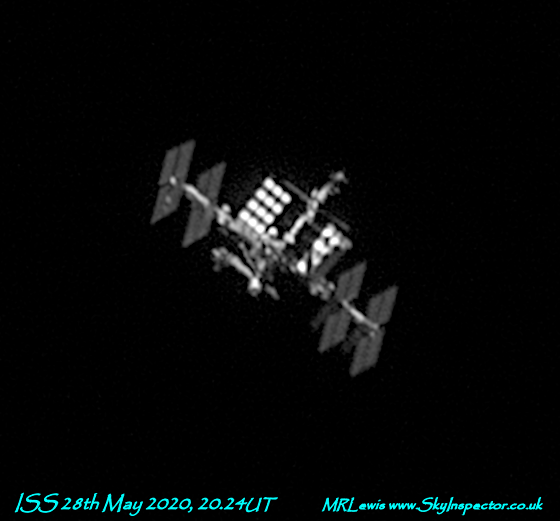Observation by Martin Lewis: ISS 27th May 2020
Uploaded by
Martin Lewis
Observer
Martin Lewis
Observed
2020 May 27 - 19:24
Uploaded
2020 May 28 - 23:01
Objects
Spacecraft
Planetarium overlay
Constellation
Hercules
Field centre
RA: 17h15m
Dec: +14°19'
Position angle: -163°44'
Field size
0°11' × 0°10'
Equipment
- 222mm Dobsonian
- ASI174MM
- 610nm filter
Location
St Albans, UK
Target name
ISS
Title
ISS 27th May 2020
About this image
Files associated with this observation
Like this image
Comments
Excellent image, Martin. The quality of these images seems to have reached a plateau of sorts, and I'm wondering how to take it to the next level. Any ideas?
I'm also curious as to how you deal with the required rapid rotation of a Dobsonian mount when the ISS passes near the zenith. Do you have to reacquire it on the other side?
Good stuff!
Chris

Think you are hovering a bit above that plateau Chris ;-)
Better images can be achieved by getting closer to Nyquist I think - so f-ratios of 3-5x pixel size in microns. Mine was at f15 but I would have picked up more detail at f29. I'm having to under-sample to keep the field size up otherwise there are too few occupied frames. Also operating at a lower f-ratio keeps the number of photons per pixel up for the short exposure times that are unfortunately needed to prevent motion blurring.
The way to step-up in resolution is to move away from manual guiding which then allows more appropriate image scales closer to Nyquist. You can then also increase the exposure times to reduce noise because you won't have to worry about motion blurring during hand guiding. Great for me would be the ASI174MM operating at f29 and 4msecs and gain 240 (which minimises read noise without risking burning out more reflective parts of the ISS). Maybe I'll try those settings and manual guiding- might hit lucky and get a small handful of usable frames to see what they would be like. Most likely there would be very few frames and they would all be ruined by motion blur.
You can see what can be achieved with automated tracking and a C11 for Philip Smith's entry here; https://spacestationguys.com/iss-close-ups/ just staggeringly good. Autoguiding also allows you to stack a load more frames to pull out further detail on sharpening as you have so many more occupied frames.
On your other point about Dobsonians and overhead passes - they are very difficult to cope with! The phrase 'and pivot...' comes to mind!
A 60-70 deg pass is ideal for me. This was an 80 deg pass and I had an accident just before the start of capture where I quickly tried to shift the scope to view round a nearby tree. Moved it okay but I unfortunately leant against the focus button and it whirred out of focus with seconds before the pass started. Had 60secs or so to get it in focus using nearby Moon and start capture but by the time I was ready I saw the ISS was almost overhead. Nightmare! Cool head required but fortunately managed to get some nice frames in with only about 30secs of the run left before ISS disappeared behind roof to the east of me. Such are the adventures of an ISS imager!
Martin
Copyright of all images and other observations submitted to the BAA remains with the owner of the work.
Reproduction of work by third parties is expressly forbidden without the consent of the copyright
holder. By submitting images to this online gallery, you grant the BAA permission to reproduce them in
any
of our publications.


